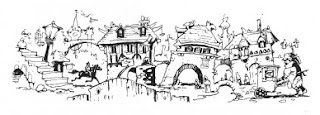We were deeply saddened yesterday to learn of the passing of fan-favourite Fighting Fantasy artist Martin McKenna, at the beginning of September.
If there is one
artist who encapsulates the way the art of the Fighting Fantasy gamebooks developed
over the years, in terms of tone as well as subject matter, it has to be Martin
McKenna. He illustrated 12 FF gamebooks in total, and ended up producing covers for 18 of them in their various different editions.
He also produced the wraparound cover art for Jonathan Green's YOU ARE THE HERO - A History of Fighting Fantasy Gamebooks. When interviewed for the book, he didn't attribute his success to one big break:
“It
was probably more like a lot of little breaks. Really early stuff like
meeting Steve Jackson and Ian Livingstone in ‘86 was helpful. They liked
the fanzine work which had included a Fighting Fantasy spoof, and they
recommended a submission to Warlock
magazine. Coincidentally Marc Gascoigne had seen my fanzine stuff and liked it,
and he was then editor of Warlock. Most importantly, an invitation came from John Blanche, then art director at
Games Workshop, to produce work for him. John’s initial contact came as a
result of me entering an art competition featured in the Citadel Journal. Instead of the hoped-for prize of a two quid
postal order, I got a letter from John expressing interest in my stuff. This
led to my very first paying commission: illustrations for an Out of the Pit
article in Warlock. So a bunch
of things came together in the very beginning. And one way or another
they've continued to do so ever since.”
Daggers of Darkness was the first Fighting Fantasy adventure to feature Martin's artwork, after he was commissioned to illustrate the book when he was aged just 17 years-old, and still at school!
Illustrations from Daggers of Darkness.
He soon became the go to guy for horror-themed titles, illustrating not only Vault of the Vampire and Revenge of the Vampire, but also Dead of Night, Legend of the Shadow Warriors, Moonrunner, Curse of the Mummy, Howl of the Werewolf and Night of the Necromancer.
Illustrations from Vault of the Vampire.
Illustrations from Dead of Night.
Illustrations from Legend of the Shadow Warriors.
Illustrations from Moonrunner.
Illustrations from Revenge of the Vampire.
Illustrations from Curse of the Mummy.
Illustrations from Howl of the Werewolf.
Illustrations from Night of the Necromancer.
Over the years Martin's style matured and developed, as he moved from drawing with a fine pen and ink on paper to working digitally, which allowed him to draw fine white lines on black, as well as vice versa. This, coupled with modern printing techniques,
meant that his more recent illustrations are some of the most detailed ever to
appear in Fighting Fantasy gamebooks.
Martin's first cover for a Fighting Fantasy gamebook did not appear until the last title in the Puffin Books' run - that of Curse of the Mummy. Produced using traditional media, Martin would later touch it up digitally for the Wizard Books re-release of the title.
The cover for Curse of the Mummy, by Martin McKenna.
Ian Livingstone's later Puffin FF gamebooks were all illustrated by Martin McKenna, as was the first new Fighting Fantasy adventure published by Wizard Books, Eye of the Dragon. Indeed, Martin's work most recently appeared in the new edition of Ian Livingstone's Return to Firetop Mountain, introducing his art to a new generation of Fighting Fantasy fans, who will now be able to appreciate how great a loss his passing is to older FF fans.
Illustrations from Return to Firetop Mountain.
Illustrations from Legend of Zagor.
Illustrations from Eye of the Dragon.
On hearing of Martin's passing, Ian Livingstone put into words what no doubt everyone is thinking at this time: "Absolutely shocking and a tragic loss of life."
Steve Jackson had this to say: "Martin will always be remembered as one of the principal and most prolific of the Fighting Fantasy artists."
He will be truly missed, and our thoughts are with his family and friends at this very difficult time.
In memory of
Martin McKenna
1969-2020
Those who knew what a genuinely kind person Martin was wanted to do something to honour his memory and so are in the process of setting up a charity in his name, which will help disadvantaged children gain access to arts programs.
If you feel able to help, and would like to make your own small donation in Martin's name, you can
do so here.





















































